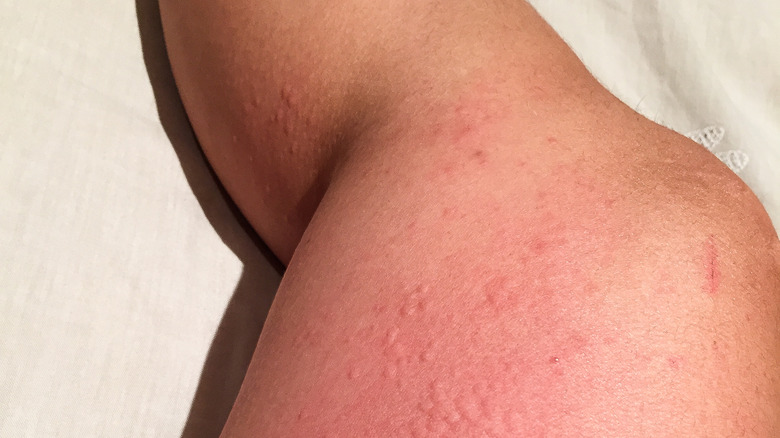The Reason Your Skin Itches In Winter
Many of us deal with dry skin at the first signs of colder temperatures, and the itching that often accompanies these patches of flaky skin can be a real bother. While the occasional urge to scratch during the chillier months of the year isn't entirely unusual, for some people, itchy skin is a symptom of a health condition known as "winter itch," which is referred to medically as "pruritus hiemalis" or "asteatotic eczema."
Characterized as a form of dermatitis, winter itch causes sufferers to have the constant urge to scratch at their dry, scaly skin. Unfortunately, that scratching may worsen symptoms, leading to cracking or bleeding.
Why winter itch occurs isn't entirely clear. The lack of moisture in the air during wintertime is thought to be one factor. Exposing your skin to heat, such as when cranking up your thermostat during bouts of cold weather, can suck even more moisture from the air as well as your skin. Wearing clothing items made of rough, insulating materials like wool may also exacerbate the condition. Cold weather can slow blood flow and this, too, can make you itchy. Decreased sebum production in the elderly, radiation, nutritional deficiencies, low thyroid activity, diuretic and antiandrogen use, and cancer can also sometimes contribute.
Winter itch follows certain patterns
Older adults appear to be particularly vulnerable to winter itch. In a 2019 study published in Future Science OA, researchers analyzed self-reported data from more than 40 Danish seniors in nursing homes about itching frequency, with most participants being female. Over 42% of patients were found to have experienced daily itching within the last year, with the sensation being at its worst during the fall and winter months. Most often, pruritus impacts the lower extremities, such as the legs. This can also include the ankles, backs of the knees, and inner thighs. It can lead to infection or skin lesions without treatment (via StatPearls).
To help manage winter itch, try keeping your showers short and cool, patting your skin dry afterward, and promptly lathering on a ceramide-based over-the-counter lotion, Vista Dermatology suggests. Hydrocortisone 1% cream can also be effective in providing relief. However, if you find that your itchy wintertime skin stems from hives rather than dry patches, a rare health condition known as "cold urticaria" could alternatively be the cause.
Cold urticaria is a more rare cause of winter itch
Emerging as hives or a rash, cold urticaria is an allergic skin reaction that occurs when the body comes in contact with cold temperatures (via Cleveland Clinic). This allergic reaction can occur in response to sipping on an ice-cold drink, swimming in frigid water, or being outside on a frosty winter day. Those with the condition may experience swelling, redness, bumps, or itching. However, you likely won't notice these signs right away, as symptoms tend to develop in the minutes after skin begins to warm up again. Although genetics can play a role in instances of familial cold urticaria, the majority of cases don't involve a family medical history of the condition.
Physicians can usually diagnose patients by observing their skin's response to direct contact with an ice cube, although additional testing is sometimes needed. If found to be unrelated to an alternate health condition, treatment for cold urticaria generally involves avoiding known triggers. If you must venture outdoors during the winter, be sure to bundle up from head to toe. Because those with more severe allergic reactions to cold air may experience fainting, heart palpitations, or breathing difficulty, it's important to have help nearby as you step outside. However, such cases are exceedingly rare. Additionally, because cold urticaria occurs due to the body's release of histamine, taking an antihistamine can help mitigate an allergic reaction.



